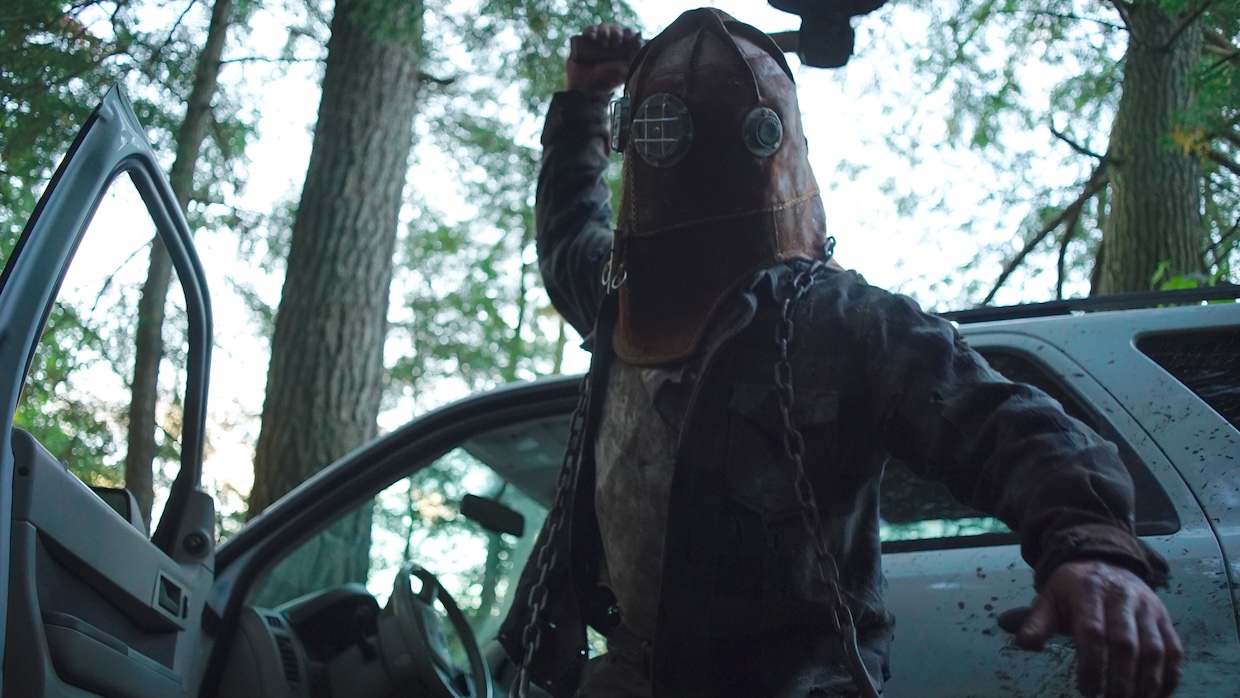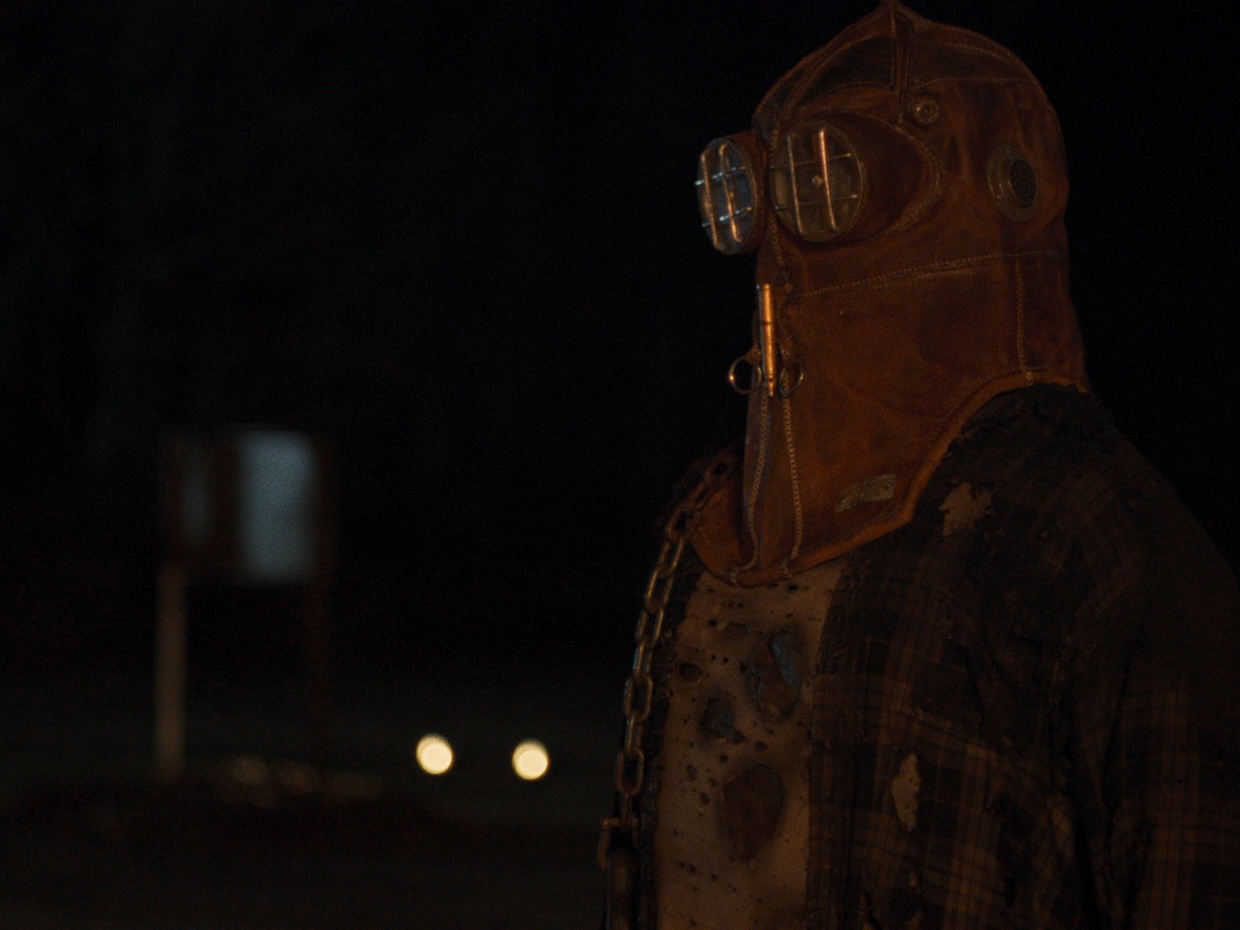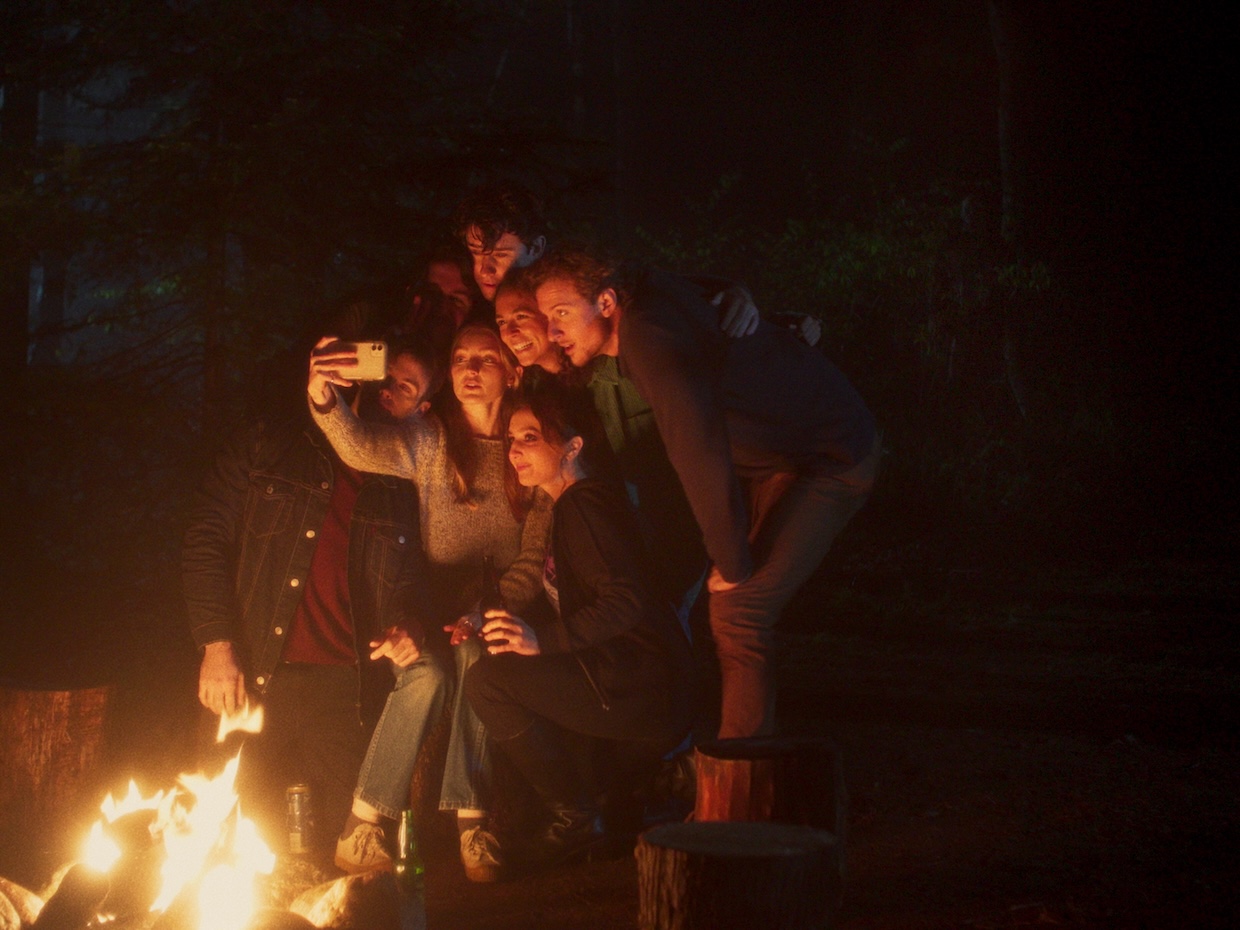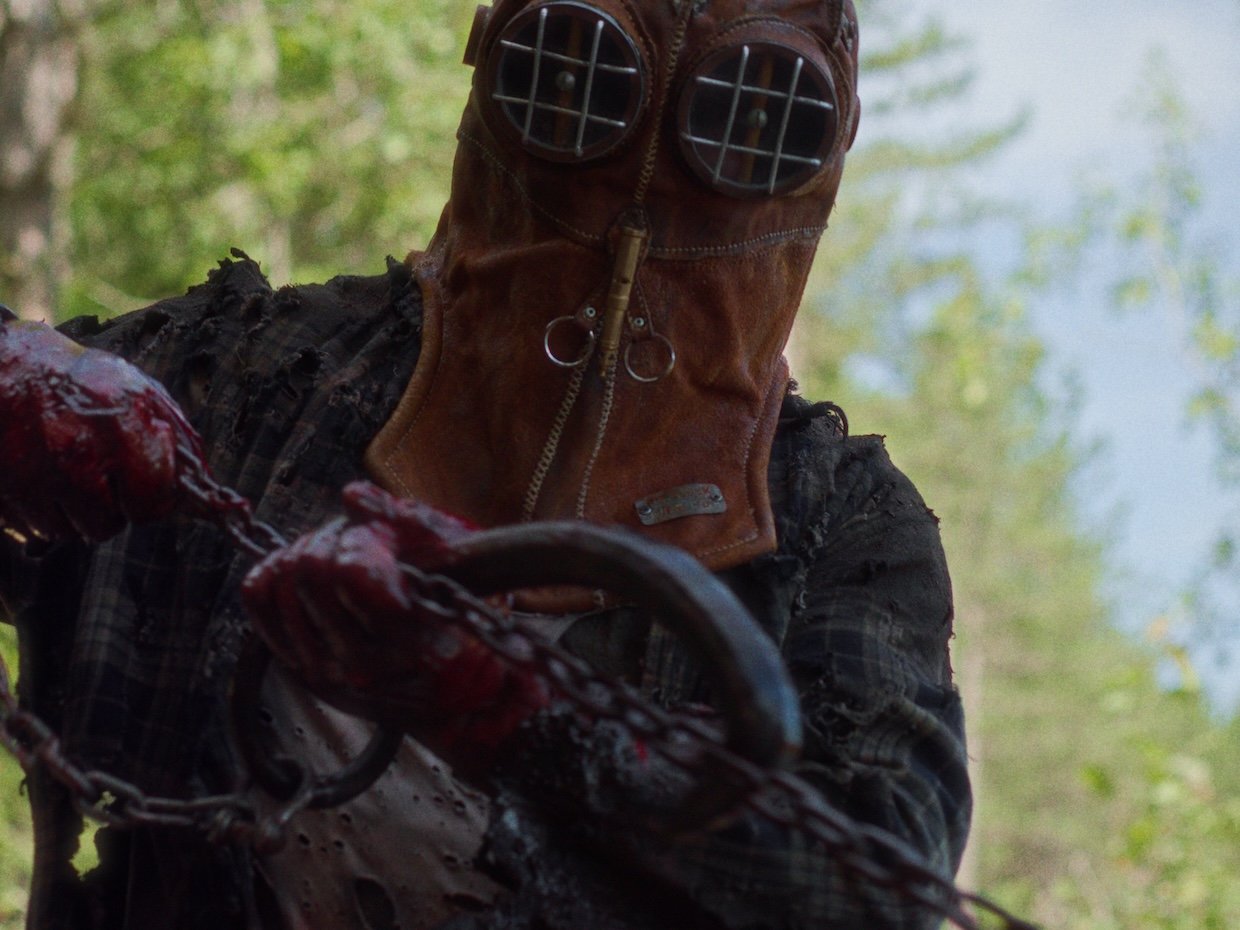 Back to selection
Back to selection
Shutter Angles
Conversations with DPs, directors and below-the-line crew by Matt Mulcahey
From 2nd Unit to Second Shoot: DP Pierce Derks on In a Violent Nature
 Ry Barrett in In a Violent Nature
Ry Barrett in In a Violent Nature Abel Ferrara has said, “In movie making, money is no excuse. It doesn’t cost anything to set up a cool looking shot.” In a Violent Nature is the embodiment of that credo. A deconstruction of the slasher genre, the movie tells a familiar story from an unfamiliar point of view as the camera stays with its undead killer Johnny (adorned in a vintage fireman’s mask and armed with a pair of logging hooks) as he traipses through the forest from victim to victim. The film poses the question, as director Chris Nash puts it, “What if Gus Van Sant directed a Friday the 13th sequel?” Or, if you prefer editor Alex Jacobs’ hypothetical, “It’s like if Pablo Larraín’s Jackie was about Jason Voorhees.”
That stylistic cross-pollination was not easily obtained. Principal photography began in September of 2021, but four weeks into the shoot—with roughly 80 percent of the movie completed—the original actor playing Johnny fell ill and production shut down. Initially the plan was to simply pick up the rest of the missing footage, but once Nash began editing he found himself underwhelmed. It was decided to reshoot the movie in its entirety using what remained of the budget. Pierce Derks, a veteran of second unit practical effects work who served as on-set documentarian on the initial shoot, stepped into the cinematographer role for the redo.
With In a Violent Nature now out in theaters, Derks spoke to Filmmaker about his Frankenstein gimbal rig, battling Ontario black flies and shooting on the $5,000 Canon C70.
Filmmaker: What was your understanding when you wrapped the first portion of the shoot? Did you think you were going to be back shooting relatively quickly to finish the movie?
Derks: When the illness with our original Johnny first happened, we were already so deep into it. We foolishly thought to ourselves, “We’ll just get someone else in the suit.” They did that all the time on the Friday the 13th movies and even the Halloweens. They had people floating in and out of those costumes. But the problem is that those movies have massive gaps in [screentime] between [appearances of the killer], and even then you’re only seeing them on screen for very short segments. You’re not spending most of the running time being so intimately familiar with how the character moves. As soon as we tried to get anyone else in [the costume to play Johnny], none of it worked. There were a lot of other issues that happened [on the initial shoot] as well with the weather and the gear. It was a difficult thing because when we got back from that initial shoot we were thinking, “Okay, we’ll just reconvene and inevitably have to reshoot some stuff.” Then we started working on an assembly cut, and that’s when they decided to pull the trigger and reshoot the entire movie on, basically, our postproduction budget.
Filmmaker: I wondered if a whole new budget had to be raised or if it was just like, “We’ve got 25 percent of the money left and that’s what we’re working with.”
Derks: Yeah, the question was definitely, “How do we shoot this movie and give Nash the vision he wants, but with a lot less physical resources?” Part of that was by design, but part of it was definitely due to budgetary limitations. I was figuring out how to strip things back and then maxing out some credit cards to assemble a DIY Steadicam setup. So much of the equipment was sourced from Facebook Marketplace. When we came back we had a really, really small core team. The entire camera department was just me and one camera assistant.
Filmmaker: Were you dumping all the footage after wrap yourself?
Derks: Our producer Peter [Kuplowsky] was dumping during lunch, because we were often in these very remote locations. But I did have to worry about things like making sure that we had all our batteries charged and going through and reviewing the footage and making sure everything was dumped over. Everyone was wearing many, many hats.
Filmmaker: For that second shoot, production went from an Alexa Mini to a Canon C70. You reduced your grip/electric footprint significantly in terms of gear and crew. And, like you mentioned, you put together this DIY solution for all the smooth tracking shots where we’re traveling behind Johnny. On the original shoot, did they have an actual Steadicam?
Derks: They had a Ronin 2 with Zeiss Super Speeds, and they were also using an Antigravity rig with the big old arms that kind of float down. The big problem with that was going through the woods with it, because it was getting caught on every single branch. It was also casting shadows in every single shot. I don’t know if it was just that particular Ronin or what the deal was, but it just never wanted to balance the camera. It was constantly freaking out. It felt like half the days [on the initial shoot] were just trying to work around this camera rig. It’s great in really controlled environments, but in the kind of remote locations we were shooting in, having a traditional camera package was more of a hindrance than a benefit.
Filmmaker: That Canon C70 is only about $5,000. Did you guys just buy it? Did you have a back-up body in case you had issues out there in the wilderness?
Derks: The budget was so tight that we didn’t even buy the camera. It was a rental. I looked at a ton of cameras during prep [through the lens of] “What will give us the look that we’re after, and what will actually work in terms of getting to our locations?” Because even though we were in remote locations for that first block of shooting, when we went back the second time with the reduced crew, we decided to go to even more remote spots, because Nash wasn’t super happy with the locations from the first shoot. We actually just had the one camera body. I sourced the collection of lenses that we used [including Canon FD primes]. We did buy a Ronin RS 2 and I put together all the pieces to create this sort of hybrid Steadicam setup that we used for most of the tracking shots.
Filmmaker: You’ve got to name that thing like “the DerksCam” or something.
Derks: Yeah, it was a complete Frankenstein creation that wasn’t pretty to look at because all of it was sourced together from different pieces. Honestly, that just comes from my background of having worked on so many genre films and doing so many second units and getting so intimate with practical effects. I’m used to not caring about what something looks like. All those practical effects and prosthetics are always just a mess of wires and two-by-fours, then you have the one pretty part that goes on screen at the end. The rest looks like a complete mess. So, it’s never bothered me to have gear that doesn’t look slick or that looks a bit like a monster itself, as long as it gets the job done.
Filmmaker: Break down the rig for me. You had a Steadicam-like vest and spring arm, a Glidecam sled and on top of that you rigged that Ronin RS 2. How did that affect the way the camera movement felt, to essentially combine two stabilizers on top of each other?
Derks: We knew there was no way we could rely on a traditional Steadicam system because of the footing that we had out there. These were not clean trails. For the most part, you could not do the classic ninja walk while operating. You had to do big, heavy steps. With a traditional gimbal, we found that it would still give this big up and down wobble [on that terrain]. That just felt a little bit too robotic, then there were other rigs that were almost too smooth. We wanted the audience to always feel that the camera was tethered to the character and location and wasn’t just a floating omnipotent presence. A lot of our references were things shot on older Steadicam systems. We loved to have that little bit of sway that those systems had, and we found that by putting the [Glidecam and the RS 2] systems together. It wasn’t too robotic, but it wasn’t too ethereal either. It was somewhere in between where it felt alive and organic.
Filmmaker: Was that rig difficult to balance?
Derks: It was definitely a learning curve. The first couple of times we shot with it, the balance was off. It was something we had to troubleshoot as we went through the production. The workaround that I found was that I would mount the RS 2 directly onto the Glidecam pole so that it was centered. Toward the end of the production I could do it even without thinking about it, but at first it was like, “I’ve created this monster. Now, how do I actually use it?”
Filmmaker: Could you attach the RS 2 directly to the quick plate on the Glidecam?
Derks: I bought an adapter that is normally used for car mounts, where you don’t have to have the long pole battery that’s normally included at the bottom of that gimbal. We had an adapter that we could then plug into a D-Tap connection. I had the weight of all the batteries and the transmitters actually strapped to my vest, then ran everything off of D-Tap extenders off the arm into the camera itself, because the RS 2 doesn’t have that big of a weight limit to it and we were already pushing it with the camera and the lenses. It was definitely a challenge to find ways to limit the weight but still get all the functionality that we needed out of the camera.
Filmmaker: Did you use one consistent focal length for those tracking shots behind Johnny?
Derks: We mainly used two focal lengths. The most common one was a Canon FD 24mm S.S.C. That was kind of our default Johnny tracking lens, but when we wanted to really sell the environment or have things even feel a little bit more off-kilter, we would use an 11-16mm [zoom]. The long walk with Johnny following the cliff death sequence is on the 11mm because we wanted to feel the full breadth of the trees and the vertical frame.
Filmmaker: Overall, what was your impression of the Canon C70?
Derks: I was really happy with it. Sometimes the rolling shutter can be a little janky, but that’s an issue with so many cameras. In terms of highlight retention, it performed fantastically. It essentially uses the same sensor as a C300 Mark III, just in a smaller, more condensed body, which was perfect for us not only for budgetary reasons but also for lugging the camera around. It was important to have a camera package that I could literally throw in a backpack and take to where we needed, as opposed to trying to have multiple assistants hauling camera carts to bring all the stuff out. That was just not feasible with where we were shooting.
We shot most of the film in Canon RAW at 800 ISO, which is the base, then for nighttime scenes we switched to, I think, MXF, because Raw turns off a little bit of noise reduction and we wanted that. I did boost the ISO for a few particular night scenes to get a little bit more grit and grain out of it. When Johnny walks out [of the ranger station] wearing his mask for the first time, we shot that at a really high ISO. I love the texture that it had. It felt almost like Super 16.
Filmmaker: How’d you land on the 1.33 aspect ratio? I think of the golden era of slashers as being from the late-1970s to the mid-80s, when not many films were shot in that ratio. However, Elephant and some of the Gus Van Sant movies that partially inspired In a Violent Nature’s style are 1.33.
Derks: It was a combination of things for Nash, but one of the things that inspired the 1.33 was the sensation of watching Friday the 13th and old slasher and horror movies on VHS as a kid, because they were cropped. He wanted to evoke that feeling. We did test with 16:9—the C70’s censor is actually 16:9—but started to lose the sense of symmetry. We really liked the feeling of Johnny being an equal [part of the frame] with the forest. When the frame got wider, it felt like it was more about the forest and less about the harmony between Johnny and his environment.
Filmmaker: One of the only scenes that strays from Johnny’s perspective is the campfire exposition, where one of the potential victims relays Johnny’s backstory. It’s a circular dolly shot at night, which sounds like a challenge with a small crew and a limited number of lights.
Derks: Yeah, the campfire scene was a tricky one. It was one of the few times we were on a more controlled [camera movement system] like a slider or dolly. We built a small platform surrounding the area where the campfire would be, because we knew that we would not have enough time to actually properly balance out the circular dolly track [on the ground] on the day. So, we just built a platform and leveled it out. To make things even more difficult, it was also raining that evening and after a couple of takes the actors were soaked and we had to call it. In terms of our G&E package, almost all the exteriors were run exclusively off one 2K generator. The strongest light that I ever had going was an Aputure 600D, and we never had any lifts. Our biggest stand was a Mombo Combo. We were always trying to find ways to hide stands behind trees. We wanted to get just enough light to get some detail and texture on the trees, so it didn’t feel like we were just in some black, empty void that felt like a studio space.
Filmmaker: There’s a shot at the forest’s ranger station where the camera is looking in through the windows. Inside, on the ground, there’s two rectangular pools of light. Johnny [played in the reshoot by Ry Barrett] smashes open a window, and the glass falls perfectly into one of those pools. He then tosses a severed head in, and it also lands perfectly in the other pool of light. Finally, he opens the station door, and his shadow is perfectly framed in the shot. How difficult was it to nail all those pieces in a single take? Was that head toss a visual effect? It just seemed impossible to nail that throw so perfectly.
Derks: That was actually one of the first shots that we did when we came back to reshoot. I think that’s actually the first take in the movie. Everything just worked out and the head landed in the right spot.
Filmmaker: No way. On the first take the head rolled around and landed right in the light with the eyes facing the right direction?
Derks: Yeah, we never anticipated it landing in the light. We were just hoping that you would feel the motion of it flying through the frame. The glass was already removed, then when Johnny’s punch came through, we just threw the glass onto the right spot. We had some sandbags next to the door so that when [Barrett] opened the door it would land in the right place. That shot was exciting for all of us, because it was like, “Oh, maybe the movie will work this time. Maybe we’ve got something here.” That’s usually the kind of crazy shot a second unit would spend forever trying to get right. It felt like a little bit of magic that all these things that shouldn’t work somehow worked out on the very first take.
Filmmaker: Was the cliffside yoga kill something that was also shot during the first go-round?
Derks: The bodies had been built, but we never got around to actually trying to film that scene. The original location we’d chosen for that was an even more remote cliffside that was way smaller. It only had maybe 10 to 15 feet of actual standable ground. When they were trying to shoot it the first time around, there was a massive rainstorm. Instead of our trail, there was now a river there. The ATVs they hired to go up to the location got stuck. There was no reception. We were so deep in the woods that it was messing with the walkie connections. So, they never were even able to attempt to shoot that scene the first time, but the bodies [for the special effects] had been made. I don’t know where they were chilling for all those months in between. (laughs)
Filmmaker: You have pretty extensive experience working on 2nd Units for practical effects like that. Was that yoga kill effect particularly difficult?
Derks: It honestly wasn’t that difficult from a camera perspective. The true heroes of that scene are the effects artists. We shot that sequence over two days—one day with the actress, the next day with the puppets. We also filmed a couple little additional pieces later on. So much of my background is doing second unit—filming monsters and puppets and things like that. I love shooting that type of stuff. It’s the realm where I feel most comfortable and confident because I’m so used to the little tricks that you need to sell that stuff.
Filmmaker: One of the reasons that scene works so well is that it’s so much gorier than the death scenes that precede it. Directly before that, there’s a kill that takes place almost entirely in a static wide. The camera is on one side of a lake, then way in the distance on the other side we see a victim pulled under water. As an audience, you kind of go, “Oh, that’s this movie’s M.O. It’s going to be clever, elegantly composed minimalist death scenes.” Then the next one is this crazy gorefest.
Derks: So much of the movie is about lulling the audience into a false sense of security. You want them to let their guard down and almost be like, “This is actually kind of nice, being out here in this nature. Everything is so lovely.” Things are picturesque and beautiful until suddenly they’re not.
Filmmaker: There’s another kill featuring a high angle, bird’s-eye view tracking shot. I figured you didn’t have a crane out there with that terrain. It didn’t feel like the way a drone moves to me and it would be really difficult to get one through all the tree branches. And I thought cable cam would be too complicated with a smaller crew. How did you do that shot?
Derks: It actually was a cable cam. We borrowed it from someone, which is how we were able to afford it. We couldn’t afford the best wire, though. It was safe, but the cable cam was not necessarily in the best condition. The gears were a little bit rusty, and things didn’t exactly move the smoothest. The wire only really had “x” number of travels out of it before it started to get a little bit too rickety and needed to be taken down. We set up the cable cam as high as we could get it and slapped the 10mm on it. One thing that was actually nice about the terrain is that it rose up as we moved further down the path. So, we got a little bit of a reframe. We started out a little bit wider, then the further we went into the shot it gave us almost like a zoom where we were getting closer and closer to Johnny.

Filmmaker: In a lot of the behind-the-scenes photos, everyone is wearing these yellow nets. Are those for bugs?
Derks: Yes. Northern Ontario is notorious for its black fly season.
Filmmaker: Are those like horseflies?
Derks: Kind of, but smaller. The black flies would latch on to you and it doesn’t matter how many layers you’re wearing—they will just continuously chew through the layers. One day I counted after we were done filming and I had almost 200 bites on me, and that was with the bug spray and those nets and I was wearing like wool and all these layers. They were absolutely relentless.
Filmmaker: You had to operate wearing those nets over your face?
Derks: Yeah, some of the time I had to operate with the net on and the bugs would still be crawling through. It didn’t really bother me most of the time if the bugs were on me, but what was pissing me off was when the bugs would land on the lens and swarm around the camera. They’re attracted to heat. It’s so embedded in me as part of the camera department to wear black, so you don’t cause any reflections and don’t interfere with the lighting. But because of that, the bugs were extra attracted to the heat [from that black clothing] and also the heat from the camera. There was this little cartoon cloud of bugs circling me everywhere that I went. For some shots our producer was off to the side waving a flag to try to keep the bugs from completely obscuring the frame. Our sound team, Tim Atkins and Michelle Hwu, latched onto that and created this motif of this ominous sound of flies buzzing that ended up being almost like an indication that death was on its way. It added an extra layer of texture to the film, but it was miserable trying to work that way.




